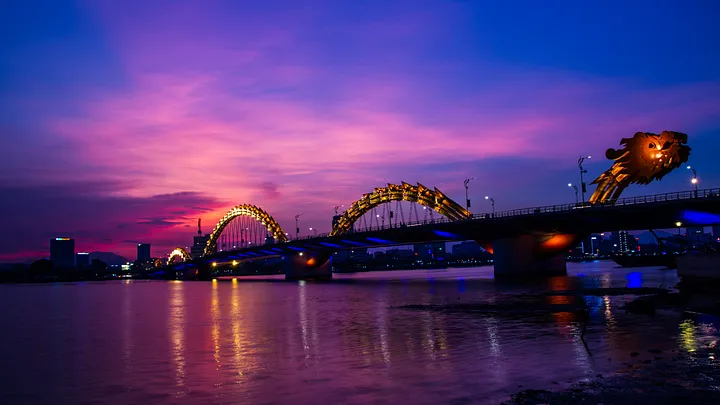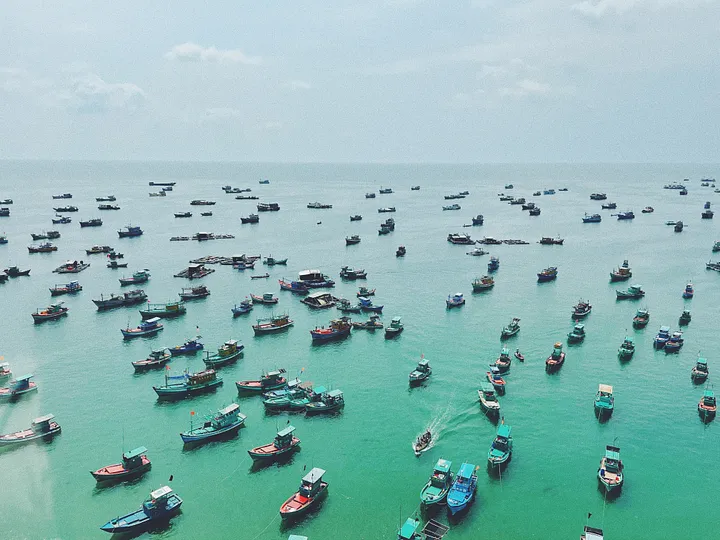35 years of Đổi Mới (Economic Reform) helped Vietnam from a country that had to “run for rice” (see note 1) in the early 1980s to become a middle-income country, reaching the top 20 of the world’s leading economies in terms of international trade. The Reform has turned many poor rural areas into industrial districts, farmers into city dwellers, the number of poor households has decreased sharply, the middle class has increased rapidly… But the Reform process also led to the “Reorder” among provinces and regions.

Photo by Ngô Thanh Tùng on Unsplash
Da Nang and the geopolitical distance
After the country’s unification, when it comes to big cities in our country, after Ho Chi Minh City and Hanoi, people often call the name Da Nang. But in reality, it is a reputation with no substance; in terms of economic scale (GRDP), the third position of Da Nang does not exist. At the time before the Covid-19 pandemic, Da Nang’s GRDP was nearly 5 billion USD, only equal to about 7.9% of Ho Chi Minh City, 11% of Hanoi, 40% of Hai Phong, 28.4% of Dong Nai, 29% Binh Duong, 54% Bac Ninh, 65.4% Quang Ninh and lower than Thanh Hoa and Vinh Phuc. Even Da Nang’s GRDP is only equivalent to 25% of Thu Duc city of Ho Chi Minh City.
Many people wonder why a city that always leads in the titles of “smart city” and “e-government”, a city that is said to be the most dynamic in the central region, a place worth living in Vietnam, whose future is comparable to the big cities in Asia, and moreover, for many years, a city that tops the Provincial Competitiveness Index (PCI), has such a modest economic scale?
But that is the reality, reflected not only in GRDP but also in low investment attraction, especially FDI (2021 only $150 million USD, accounting for 0.48% of $31 billion USD in the whole country) as well as attracting manpower.
In 2021, the budget revenue in Da Nang is just over $21,000 billion VND compared to Hai Phong’s over $90,000 billion, Quang Ninh’s over %51 trillion, Vinh Phuc, Bac Ninh, Thanh Hoa each province $32 trillion and the whole Quang Nam’s $23,772 billion … not to mention the cities and provinces that are many times higher such as Ho Chi Minh City, Hanoi, Ba Ria — Vung Tau, Dong Nai, Binh Duong.
Obviously, in economic terms, Da Nang City is not only inferior to nine provinces in the top 10, but has a long distance from the geopolitical position of Da Nang itself when it is always named after Hanoi, Ho Chi Minh City, and before Hai Phong? The first reason is due to low FDI and domestic investment attraction, leading to the smallest industrial scale in the top 10. For example, Binh Duong province is a large industrial center thanks to 4,016 FDI projects (more than $37 billion dollars) and 48 industrial zones and clusters (IZs); Dong Nai province has 35 industrial parks with an area of 12,000 hectares, capital of over $30 billion dollars; Vinh Phuc province has nearly $8 billion USD in FDI capital, has 14 industrial parks or Quang Ninh alone in 2021 attracting more than $361 trillion VND private investment capital… Meanwhile, the total FDI investment in Da Nang in the past 25 years has not been equal to the year 2021 alone of Hai Phong ($5.26 billion USD) and currently has only 6 concentrated industrial zones…
Some reasons for Da Nang’s low growth were pointed out by Prime Minister Pham Minh Chinh during a meeting with the city’s leaders in last December: not many large enterprises, low FDI attraction, not many high-tech projects, and source technology. The Prime Minister directed: “It is necessary to promote research and restructure the economy in a more harmonious, balanced, and appropriate manner”. On the other hand, although tourism services are considered the mainstay, in fact, Da Nang has not surpassed Khanh Hoa, Quang Ninh, Kien Giang… There are also opinions that the high rankings have not been proven by the results of attracting investment, human resources, and economic scale … plus the “trail of appreciation” that Da Nang has always been accepted also makes this city “move slow”?
Is it true that Da Nang is facing the fact that it is difficult to keep the 10th position out of 63 provinces in terms of the GRDP scale when many provinces behind are rising strongly? They are Thanh Hoa (with Nghi Son economic zone and petrochemical refinery), Thai Nguyen (a new investment center of Samsung), Long An (ranked second nationwide in terms of FDI in 2021), Bac Giang and Hung Yen (continuous wave of large FDI and domestic investment)… It is also worth mentioning the advantages that two neighboring provinces to Da Nang are strongly promoting: Quang Ngai (with the Dung Quat Refinery and Petrochemical Complex in 2021 contributing 46 % of total provincial budget revenue, and Hoa Phat Steel), Quang Nam (with Chu Lai Economic Zone and “big man” Thaco)…
Many localities have unfulfilled aspirations
During the bao cấp period (see note 2), Nam Dinh was the largest textile and garment industry center in the North, positioned only behind Hanoi and Hai Phong, not inferior to the center of iron and steel Thai Nguyen. But now, when Nam Dinh leads the country in new rural construction, ironically, it is the “poorest” province in the Red River Delta in terms of local budget revenue and GRDP. Every year, this province, famous for education, still has to receive subsidies from the Central Government for over 50% of the total local budget expenditure. As in 2019 before the Covid-19 pandemic, the central budget revenue estimate assigned to Nam Dinh was only $4,690 billion VND, much lower than the two provinces separated from the old Ha Nam Ninh, Ha Nam ($7,716 billion VND), Ninh Binh ($9,843 billion VND) and neighboring Thai Binh ($7,412 billion VND). In 2021, the budget revenue estimate of Nam Dinh province is also $5,700 billion VND. The figure of $5,700 billion VND is probably only equivalent to the net profit in 2021 that the Mobile World JSC of Nam Dinh businessman Nguyen Duc Tai achieved?!
It is not difficult to see the reason why Nam Dinh has become the “poorest” in the Red River Delta, that is, while other “rice provinces” in the region bustlingly attract investment in industrial development and tourism, the economic structure of Nam Dinh is still mainly agricultural. The central position of the textile industry in the 1960-1980s disappeared due to the inability to compete in the new mechanism; other industries and establishments are small and fragmented, with low productivity and low efficiency…?

Photo by Đăng Nguyễn on Unsplash
Not only unknown when it will no longer depend on the central budget subsidy like Nam Dinh, but Nghe An province has also had to receive rice support from the Government for many years. It is a paradox, because Nghe An has ample advantages such as “golden forest, silver sea” (see note 3), international airport, railway station, seaport, and the element of “blessed land, talented people” (see note 4), which are not comparable to all but a few [cities/provinces], but is still poor. With a population of more than 3.3 million people, the total budget revenue in Nghe An province in 2021, although increased quite well, has only reached $18,000 billion VND, while neighboring Nghe An to the north, Thanh Hoa, is passing with the Nghi Son economic zone and refinery and petrochemical complex; in 2021 the budget revenue will reach more than $32 trillion VND. And its neighbor to the south, Ha Tinh, is also growing rapidly thanks to the investment attraction of Vung Ang economic zone, Formosa Steel, Vin Group’s $4,000 billion VND electric vehicle battery factory… In this situation, it is impossible to say for sure when Nghe An will realize “Lam River Aspiration” to build Nghe An into the best province as Uncle Ho taught in his lifetime!
Reversal of Ratios between Mekong Delta and Ho Chi Minh City
Another example of “Reorder” is the reversal of the economic scale ratio (GRDP) between the locomotive (see note 5) Ho Chi Minh City and the Mekong River Delta (Mekong Delta), consisting of 13 provinces. According to the announcement at the regional conference in 2021, in 1990 the economic size of Ho Chi Minh City was only two-thirds of that of the Mekong Delta, but now the position has reversed, the GRDP of these 13 provinces is less than two-thirds of Ho Chi Minh City.
Accounting for 12% of the area and 19% of the population, the Mekong Delta contributes to 50% of rice production, 95% of rice exports, 70% of fruit production, and nearly 50% of the country’s seafood production of the whole country. Of course, this is also the area that supplies processing materials, export goods, labor force and is also a large consumption market of Ho Chi Minh City and the Southeast region.
However, in contrast to the strength of commodity agricultural production, the Mekong Delta is the weakest region in the country in terms of transportation infrastructure. The output of goods is large and continuously increasing, but because there is no large port, most agricultural and aquatic products must be exported through Ho Chi Minh City and Ba Ria — Vung Tau, transferred to the Central and Northern regions, or exported to China by road with high cost. That is not to mention road transport is often congested due to many factors, including the “erratic heat and cold” of foreign small-scale partners. On the other hand, currently, the Mekong Delta is also “in a state” of being the lowest in the country concerning education and vocational training indicators, while young people have to leave home to find work elsewhere… Because of the above-mentioned difficulties, so far in the Mekong Delta region only Can Tho city and Long An province can balance the budget, have contributed (though not much) to the Central Government, and are in the top 20 leading localities in per capita income (Can Tho 11th, Long An 14th).
In the developmental competition, perhaps “Reform— Reorder” is an inevitable and concerning cause-and-effect story. On a global scale, with the determination to continue the Reform strongly, nearly 100 million Vietnamese people hope to soon have a Reorder for Vietnam to become a developed industrialized country in the direction of modernization and high income as set in the target.
NGUYEN VAN HUNG — 13/01/2022
Translation Notes
- run for rice: original: “chạy gạo” — to earn each meal of rice
- bao cấp period: the period before the Reform when the Government and state-owned entities centrally planned and executed almost all economic activities and distributed the goods
- golden forest, silver sea: original: “rừng vàng, biển bạc” — a common phrase used with pride about Vietnam’s resource richness
- blessed land, talented people: original “địa linh nhân kiệt”
- locomotive: original: “đầu tàu” — the leading force that directs and pulls the rest